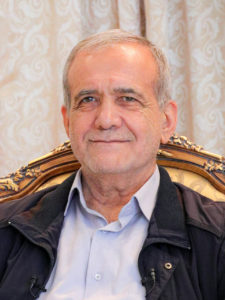ROME – Amid the recent flurry of diplomatic activity intended to persuade Iran to limit the “severe revenge” its Supreme Leader has vowed following the deaths of top Hezbollah and Hamas officials, one contact has received virtually no attention outside the specialized Catholic press, and relatively scant notice even there: An Aug. 12 phone call between Cardinal Pietro Parolin, the Vatican’s Secretary of State, and new Iranian President Masoud Pezeshkian.

This neglect of the Vatican’s potential role in the crisis reflects a long-standing secularist bias when it comes to global diplomacy, forever prioritizing realpolitik over religion, and thereby risks ignoring a potentially important opportunity.
It’s a little-appreciated fact that the Vatican – technically, the “Holy See” – and Iran have enjoyed diplomatic relations since 1954, 30 years longer than Rome’s relationship with Washington, which dates only to the Reagan years.
Unlike other historically Western powers, the Vatican never suspended its relationship with Tehran following the 1979 Iranian Revolution. Indeed, at the time the election of Pope John Paul II in 1978, swiftly followed by the upheaval in Iran, were read by some global observers as two expressions of the same root instinct – institutions that had seemed to be gradually drifting toward secularism suddenly, and surprisingly to many, reasserting their traditional religious identity.
Ever since, the Vatican has been arguably the historically Western actor with the best entrée with Iran’s leadership, for the root reason that both speak, think and act on the basis of spiritual, as well as strategic, considerations.
Moreover, there’s a physiological connection between the Shi’a version of Islam that’s dominant in Iran and the broader Persian Gulf region, and Roman Catholicism. Unlike, say, Protestantism in the Christian world and Sunni Islam among Muslims, both Catholics and Shi’ites have a clerical caste, both emphasize tradition alongside scripture, and both have a rich vein of saints, shrines and popular devotions.
In other words, from the point of view of the sociology of religion, Catholics and Shi’ites are akin to kissing cousins.
This natural affinity has been turbo-charged under the current papacy, since Francis has no higher diplomatic and geopolitical priority than reorienting the Vatican away from its traditional profile as a Western reality towards a far more globalist and non-aligned stance, and thus one more congenial to Iranian interests.
Informally, Francis has been a major supporter of the new BRICS alliance as a counterweight to the role of the G7 in global affairs. Originally bringing together Brazil, Russia, India, China and South Africa, the coalition has expanded to embrace five additional nations, including Iran. (Francis’s own native Argentina was also slated to sign up, but plans changed after the election of Javier Milei in November 2023.)
The fact that Iran is now part of a global alliance led in part by Francis’s key political ally, President Luiz Inácio Lula da Silva, has further cemented the relationship between Rome and Tehran, and provided the Vatican with another back channel of communications.
Structurally, Iran and the Vatican share several core commitments that provide the basis for enduring partnership.
Although the Vatican is an enthusiastic proponent of the two-state solution in the Middle East while Iran’s leadership has waffled, both are deeply sympathetic to the Palestinian cause, and realists in Tehran realize that Rome’s vision is more plausible than bellicose rhetoric about driving Israel to the sea.
The Vatican, which is a founding member of the International Atomic Energy Agency, also has long supported Iran’s nuclear deal, seeing it as a pathway toward peaceful uses of nuclear technology. When the U.S. abandoned the deal under the Trump administration, Pope Francis’s diplomatic team made its disapproval abundantly clear.
Perhaps most basically, the Vatican and the Islamic Republic share a common aversion to forms of Western secularism which seek to muzzle, at times even to mock, religious faith and traditional spiritual and moral values.
It was no accident, for example, that in the mid-1990s, the Vatican and Iran formed the core of what was dubbed at the time an “unholy alliance,” effectively blocking proposals during UN-sponsored conferences in Cairo and Beijing to install abortion as a new “right” under international law.
Just a couple weeks ago, Iran’s Supreme Leader, Ayatollah Ali Khamenei, was part of the global chorus condemning the opening ceremony at the Paris Olympics and its apparent parody of the Last Supper. In fact, it’s entirely possible that the reaction of Khamenei and other Islamic leaders helped cajole the Vatican to put out its own belated statement, since initially Pope Francis seemed disinclined to follow the lead of his own bishops.
All this brings us back to the current state of suspended animation, as the world awaits whatever Iran is going to do.
The hard fact of the matter is that other Western powers, most obviously the United States, but really almost any NATO member, has relatively little leverage to deploy. Their entreaties are likely to be seen by Iran’s ruling class as motivated by strategic, political and economic interests hostile to their own.
The Vatican, however, especially under Pope Francis, is a different kettle of fish entirely. That affords Rome the chance – and it is, of course, merely a chance – to act as a backdoor broker in a way no other global actor could replicate.
Whether that happens remains to be seen. Even if it does, whether it’s reported also depends on the capacity of secularist news organizations to shake off their dogmatic slumber and realize that religion actually matters.

